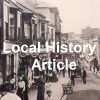86 High Street, Ventnor: part three – Joe Newnham and John Roberton
Over the last 170 years there have been various different businesses located at 86 High Street in Ventnor. By the early 1900s the premises had become Joe Newnham’s Dairy. Joe first worked in Ventnor as a wine merchant’s cellarman, but later went into business as a dairyman. He seems to have set up at 86… read more »

